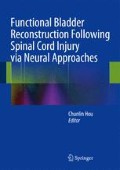Abstract
Among the many types of spinal fractures reported, thoracolumbar fracture is the most common; it is characterized by medullary cone injury, functional impairment of the sensory and motor nerves and atonic bladder [1–3]. Atonic bladder leads to severe urinary retention, refractory urinary infections, and even chronic renal failure, making it the main cause of death from medullary injury [4, 5]. Therefore, it is important to restore self-controlled urination in these patients, in order to decrease the mortality rate and improve their quality of life.
Access this chapter
Tax calculation will be finalised at checkout
Purchases are for personal use only
References
Benevento BT, Sipski ML. Neurogenic bladder, neurogenic bowel, and sexual dysfunction in people with spinal cord injury. Phys Ther. 2002;82:601–12.
Dogan S, Safavi-Abbasi S, Theodore N, Chang SW, Horn EM, Mariwalla NR, et al. Thoracolumbar and sacral spinal injuries in children and adolescents: a review of 89 cases. J Neurosurg. 2007;106:426–33.
Heary RF, Salas S, Bono CM, Kumar S. Complication avoidance: thoracolumbar and lumbar burst fractures. Neurosurg Clin N Am. 2006;17:377–88.
Blok BF, Karsenty G, Corcos J. Urological surveillance and management of patients with neurogenic bladder: results of a survey among practicing urologists in Canada. Can J Urol. 2006;13:3239–43.
Samson G, Cardenas DD. Neurogenic bladder in spinal cord injury. Phys Med Rehabil Clin N Am. 2007;18:255–74.
Chuang DC, Chang PL, Cheng SY. Root reconstruction for bladder reinnervation: an experimental study in rats. Microsurgery. 1991;12:237–45.
Sundin T, Carlsson CA. Reconstruction of severed dorsal roots innervating the urinary bladder. An experimental study in cats. II. Regeneration studies. Scand J Urol Nephrol. 1972;6:185–96.
Xiao CG, Godec CJ. A possible new reflex pathway for micturition after spinal cord injury. Paraplegia. 1994;32:300–7.
Lin H, Hou C, Chen A, Xu Z. Innervation of reconstructed bladder above the level of spinal cord injury for inducing micturition by contractions of the abdomen – to – bladder reflex arc. Neurosurgery. 2010;66:948–52.
Lin H, Hou CL, Zhong G, Xie Q, Wang S. Reconstruction of reflex pathways to the atonic bladder after conus medullaris injury: preliminary clinical results. Microsurgery. 2008;28(6):429–35.
Hiersemenzel LP, Curt A, Dietz V. From spinal shock to spasticity: neuronal adaptations to a spinal cord injury. Neurology. 2000;54:1574–82.
Storch JS. Lumbar burst fracture associated with bowel, bladder, and sexual dysfunction: case study. J Neurosci Nurs. 2005;37:68–71.
Dahlberg A, Perttilä I, Wuokko E, Ala-Opas M. Bladder management in persons with spinal cord lesion. Spinal Cord. 2004;42:694–8.
Hirsch NP. Neuromuscular junction in health and disease. Br J Anaesth. 2007;99:132–8.
Kobayashi H, Yamataka A, Lane GJ, Miyano T. Disseminated mixed intestinal dysmotility (DMID): a new intestinal ganglion cell disorder? Pediatr Surg Int. 2005;21:883–8.
Pirker ME, Rolle U, Shinkai T, Shinkai M, Puri P. Prenatal and postnatal neuromuscular development of the ureterovesical junction. J Urol. 2007;177:1546–51.
Burnstock G. Innervation of bladder and bowel. Ciba Found Symp. 1990;151:2–18.
Fry CH, Hussain M, McCarthy C, Ikeda Y, Sui GP, Wu C. Recent advances in detrusor muscle function. Scand J Urol Nephrol Suppl. 2004;215:20–5.
Hashitani H, Bramich NJ, Hirst GD. Mechanisms of excitatory neuromuscular transmission in the guinea-pig urinary bladder. J Physiol. 2000;524:565–79.
Author information
Authors and Affiliations
Corresponding author
Editor information
Editors and Affiliations
Rights and permissions
Copyright information
© 2014 Springer Science+Business Media Dordrecht
About this chapter
Cite this chapter
Zheng, X., Hou, C. (2014). Pathological Changes in the Detrusor After Spinal Cord Injury. In: Hou, C. (eds) Functional Bladder Reconstruction Following Spinal Cord Injury via Neural Approaches. Springer, Dordrecht. https://doi.org/10.1007/978-94-007-7766-8_4
Download citation
DOI: https://doi.org/10.1007/978-94-007-7766-8_4
Published:
Publisher Name: Springer, Dordrecht
Print ISBN: 978-94-007-7765-1
Online ISBN: 978-94-007-7766-8
eBook Packages: MedicineMedicine (R0)

